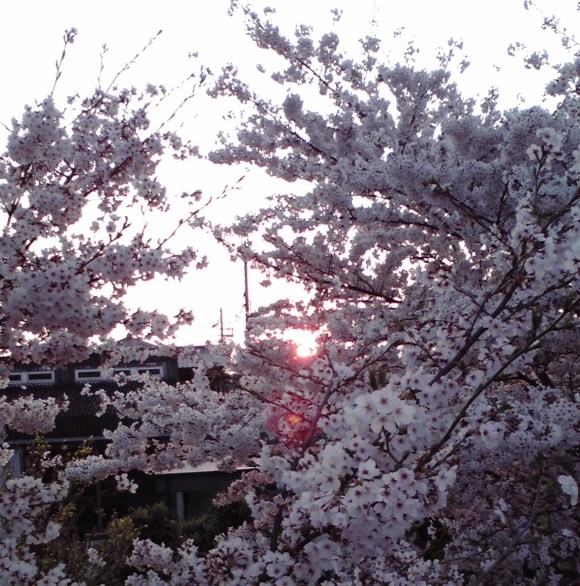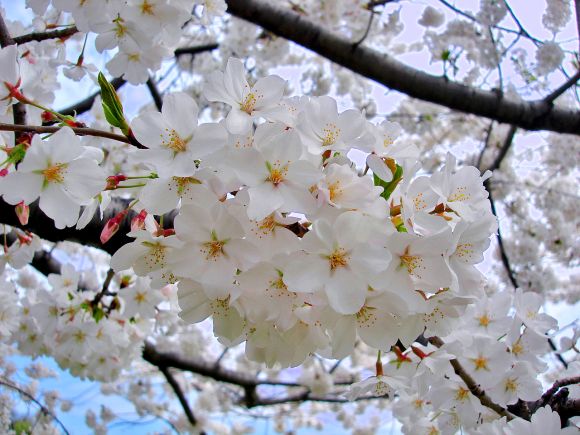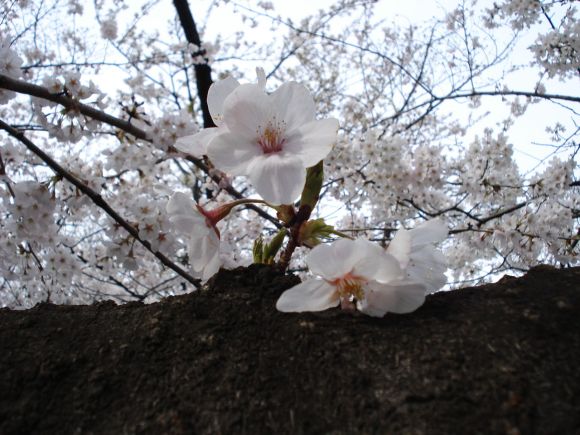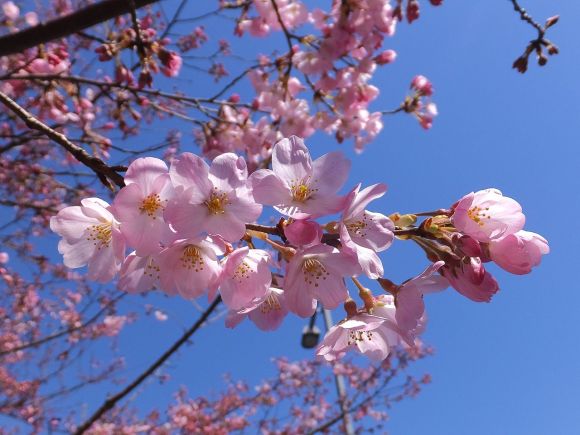
It’s that time of year again, when the cold of winter fades away and gives birth to the beautiful pink and white hues of cherry blossoms contrasted against their trees’ elegant dark branches. It’s a season long identified with Japanese culture around the world.
However, news organizations in South Korea are declaring that this has gone on long enough and are calling for a concerted effort to let everyone know once and for all that cherry blossoms are theirs.
■ Would a cherry tree by any other name smell as confusing?
This isn’t the first year the debate of cherry blossom ownership has been raised. The species in question is known as the King cherry (wangbeojnamu) in Korea and Yoshino cherry (somei Yoshino) in Japan. The even have nearly identical scientific names of Prunus Yedoensis and Prunus x Yedoensis respectively.
Those formal names likely stick in the craw of Koreans as it was assigned by Japanese botanist Ninzo Matsumura after the Edo (Tokyo) region of Japan without any substantial proof of the actual native habitat of the species.
Although there has been no definitive proof either way regarding the true home of these trees they are basically considered unique species with the King cherry originating from Jeju Island in South Korea while the Yoshino cherry is a hybrid of the King cherry but genetically distinct and native to Japan.

■ “Backed by Science”
This year’s claims by the media of pretty cherry trees having a home in Korea is said to have gotten highly credible backing by the Korean Forest Research Institute who have accumulated studies from both sides and found that the evidence supporting a Korean origin far outnumbered any evidence for Japan.
In addition, DNA found in the cherry trees given to Washington D.C. By Japan was reported to be linked to Jeju Island trees. The Institute has also found over 100 Yoshino cherry trees that they feel are native to Jeju Island based on their locations and surrounding plant-life.

■ Reaction
Naturally, considering Japan and Korea’s often tumultuous relationship the debate of what nation is the source of cherry blossoms stirs emotions on both sides. Here’s what Japanese netizens had to say.
“Here we go again…”
“So what if the cherry blossoms originated in Korea? Do they want a reward?”
“Yes, yes, they all come from Korea. We get it. What else?”
“Oh hey it’s spring!”
Meanwhile in Korea, readers of these newly galvanized claims of cherry blossom ownership reacted with an equally bored demeanor.
“There areas are so close geographically, there isn’t much point in arguing it.”
“Cherry blossoms are cherry blossoms. No need to ruin them with nationalism.”
“It’s still not proven yet?”
“In the spring Japan enjoys their modified cherry blossoms while Korea enjoys their pure cherry blossoms. Let’s just all enjoy the flowers and not waste unnecessary emotional energy.”
That last comment seems to have very nicely summed up the feeling of regular people in both countries: the flowers are pretty so who cares where they come from?

That being said, I could sympathize with Korea if the blossoms truly were native to their land but instead are deeply connected to another country. However, going around citing research and DNA analysis likely won’t win anyone over to their side.
No, the real solution would be to throw some truly legendary cherry blossom viewing parties so that the world takes notice and wants to be in Korea when those pink buds open up. With enough time and kick-ass events Korea could conceivably appropriate (or reappropriate) this culture from Japan.
Right, so that should effectively throw down the party gauntlet. Let’s all have a great cherry blossom season and may the most fun nation win!
Source: Searchina, Focus Asia, Hamusoku (Japanese) Science Direct (English)
Top Image: RocketNews24

 Sakura report 2019: First cherry blossoms begin to bloom in Tokyo
Sakura report 2019: First cherry blossoms begin to bloom in Tokyo Sakura in Japan 2019: The best spots for hanami cherry blossom viewing
Sakura in Japan 2019: The best spots for hanami cherry blossom viewing McDonald’s Japan celebrates cherry blossom season with new cherry frappe and mocha drinks
McDonald’s Japan celebrates cherry blossom season with new cherry frappe and mocha drinks Skip the crowds at Tokyo’s most popular cherry blossom spot with Meguro River Hanami Cruise
Skip the crowds at Tokyo’s most popular cherry blossom spot with Meguro River Hanami Cruise Starbucks Japan unveils new Sakura Frappuccino for cherry blossom-viewing season 2024
Starbucks Japan unveils new Sakura Frappuccino for cherry blossom-viewing season 2024 FUK COFFEE?!? Japanese cafe has a perfectly innocent reason for its startling-looking name
FUK COFFEE?!? Japanese cafe has a perfectly innocent reason for its startling-looking name Two things to do, and two things not to do, when leaving a traditional Japanese inn
Two things to do, and two things not to do, when leaving a traditional Japanese inn One of Japan’s oldest castles now lets travelers spend night on the grounds, drink in its keep
One of Japan’s oldest castles now lets travelers spend night on the grounds, drink in its keep Orange Juice Crisis ’24 – Japan’s OJ supplies drying up
Orange Juice Crisis ’24 – Japan’s OJ supplies drying up Japanese cosplayer creates amazing outfit: Sailor Moon’s transformation sequence!【Photos】
Japanese cosplayer creates amazing outfit: Sailor Moon’s transformation sequence!【Photos】 All-you-can-drink deal for US$4 in Shinjuku is one of the best finds in Tokyo
All-you-can-drink deal for US$4 in Shinjuku is one of the best finds in Tokyo Starbucks at Shibuya Scramble Crossing reopens, but is it really bigger and better than before?
Starbucks at Shibuya Scramble Crossing reopens, but is it really bigger and better than before? Should married couples in Japan be allowed to have different family names? Survey investigates
Should married couples in Japan be allowed to have different family names? Survey investigates Red light district sushi restaurant in Tokyo shows us just how wrong we were about it
Red light district sushi restaurant in Tokyo shows us just how wrong we were about it Spring Mos Burger x SpongeBob lucky bags bring us fun under the sun【Photos】
Spring Mos Burger x SpongeBob lucky bags bring us fun under the sun【Photos】 Foreigner’s request for help in Tokyo makes us sad for the state of society
Foreigner’s request for help in Tokyo makes us sad for the state of society Bad tourist manners at Mt Fuji Lawson photo spot prompts Japanese town to block view with screens
Bad tourist manners at Mt Fuji Lawson photo spot prompts Japanese town to block view with screens McDonald’s Japan’s new pancake pie is a taste sensation
McDonald’s Japan’s new pancake pie is a taste sensation Japanese city loses residents’ personal data, which was on paper being transported on a windy day
Japanese city loses residents’ personal data, which was on paper being transported on a windy day Ghibli Park now selling “Grilled Frogs” from food cart in Valley of Witches
Ghibli Park now selling “Grilled Frogs” from food cart in Valley of Witches Studio Ghibli unveils new goods that tip the hat to The Cat Returns
Studio Ghibli unveils new goods that tip the hat to The Cat Returns Studio Ghibli unveils massive T-shirt collection featuring top anime movie characters
Studio Ghibli unveils massive T-shirt collection featuring top anime movie characters McDonald’s new Happy Meals offer up cute and practical Sanrio lifestyle goods
McDonald’s new Happy Meals offer up cute and practical Sanrio lifestyle goods New definition of “Japanese whiskey” goes into effect to prevent fakes from fooling overseas buyers
New definition of “Japanese whiskey” goes into effect to prevent fakes from fooling overseas buyers Our Japanese reporter visits Costco in the U.S., finds super American and very Japanese things
Our Japanese reporter visits Costco in the U.S., finds super American and very Japanese things Japanese ramen restaurants under pressure from new yen banknotes
Japanese ramen restaurants under pressure from new yen banknotes All-you-can-drink Starbucks and amazing views part of Tokyo’s new 170 meter-high sky lounge
All-you-can-drink Starbucks and amazing views part of Tokyo’s new 170 meter-high sky lounge More foreign tourists than ever before in history visited Japan last month
More foreign tourists than ever before in history visited Japan last month New Pokémon cakes let you eat your way through Pikachu and all the Eevee evolutions
New Pokémon cakes let you eat your way through Pikachu and all the Eevee evolutions Disney princesses get official manga makeovers for Manga Princess Cafe opening in Tokyo
Disney princesses get official manga makeovers for Manga Princess Cafe opening in Tokyo Sales of Japan’s most convenient train ticket/shopping payment cards suspended indefinitely
Sales of Japan’s most convenient train ticket/shopping payment cards suspended indefinitely Sold-out Studio Ghibli desktop humidifiers are back so Totoro can help you through the dry season
Sold-out Studio Ghibli desktop humidifiers are back so Totoro can help you through the dry season Japanese government to make first change to romanization spelling rules since the 1950s
Japanese government to make first change to romanization spelling rules since the 1950s Ghibli founders Toshio Suzuki and Hayao Miyazaki contribute to Japanese whisky Totoro label design
Ghibli founders Toshio Suzuki and Hayao Miyazaki contribute to Japanese whisky Totoro label design Doraemon found buried at sea as scene from 1993 anime becomes real life【Photos】
Doraemon found buried at sea as scene from 1993 anime becomes real life【Photos】 Tokyo’s most famous Starbucks is closed
Tokyo’s most famous Starbucks is closed One Piece characters’ nationalities revealed, but fans have mixed opinions
One Piece characters’ nationalities revealed, but fans have mixed opinions We asked a Uniqlo employee what four things we should buy and their suggestions didn’t disappoint
We asked a Uniqlo employee what four things we should buy and their suggestions didn’t disappoint Sakura begin to bloom in Japan as early cherry blossom season forecast for 2020
Sakura begin to bloom in Japan as early cherry blossom season forecast for 2020 The most popular places in Japan for viewing sakura in 2024, according to local travel agency
The most popular places in Japan for viewing sakura in 2024, according to local travel agency Japanese coffee chain brings in spring with sakura-scented ground and drip coffee
Japanese coffee chain brings in spring with sakura-scented ground and drip coffee The not-so-fleeting beauty of the cherry blossoms: An alternate perspective
The not-so-fleeting beauty of the cherry blossoms: An alternate perspective Sakura season officially declared in Tokyo, earliest start to hanami on record
Sakura season officially declared in Tokyo, earliest start to hanami on record Starbucks Japan’s new sakura donuts look so good it’s like cherry blossom season is already here
Starbucks Japan’s new sakura donuts look so good it’s like cherry blossom season is already here New sakura doughnuts resemble different stages of the cherry blossoms in Japan
New sakura doughnuts resemble different stages of the cherry blossoms in Japan Japan has springtime sakura Cinnabons? Sign us up!
Japan has springtime sakura Cinnabons? Sign us up! New sakura doughnuts from Mister Donut Japan take us on a journey from bud to beyond full bloom
New sakura doughnuts from Mister Donut Japan take us on a journey from bud to beyond full bloom New canned sakura liquor beverage appears in Japan, courtesy of Suntory 【Taste test】
New canned sakura liquor beverage appears in Japan, courtesy of Suntory 【Taste test】 Starbucks Japan reveals second sakura Frappuccino for cherry blossom season 2020
Starbucks Japan reveals second sakura Frappuccino for cherry blossom season 2020 Experience the cherry blossoms early this year with AR flower art and Morinaga foods
Experience the cherry blossoms early this year with AR flower art and Morinaga foods Couldn’t catch the cherry blossoms in full bloom? We’ve got a unique idea for you!
Couldn’t catch the cherry blossoms in full bloom? We’ve got a unique idea for you! Early-blooming sakura cherry blossoms create pink-tinged wonderlands in Japan
Early-blooming sakura cherry blossoms create pink-tinged wonderlands in Japan Beautiful Kyoto snapshot of graceful heron in a swirl of sakura has much less artistic backstory
Beautiful Kyoto snapshot of graceful heron in a swirl of sakura has much less artistic backstory Sakura season 2018 officially declared in Tokyo as first cherry blossoms begin to bloom
Sakura season 2018 officially declared in Tokyo as first cherry blossoms begin to bloom
Leave a Reply